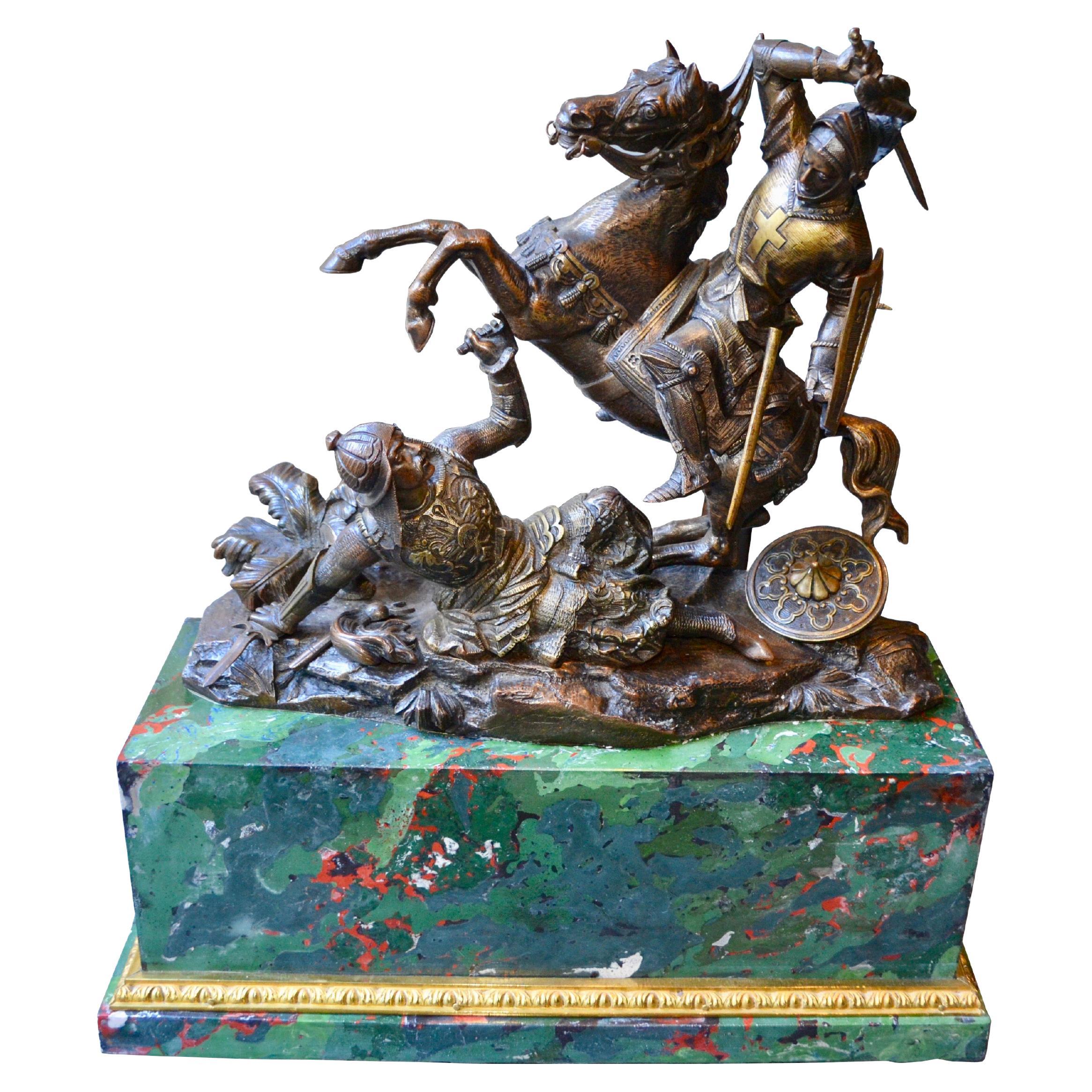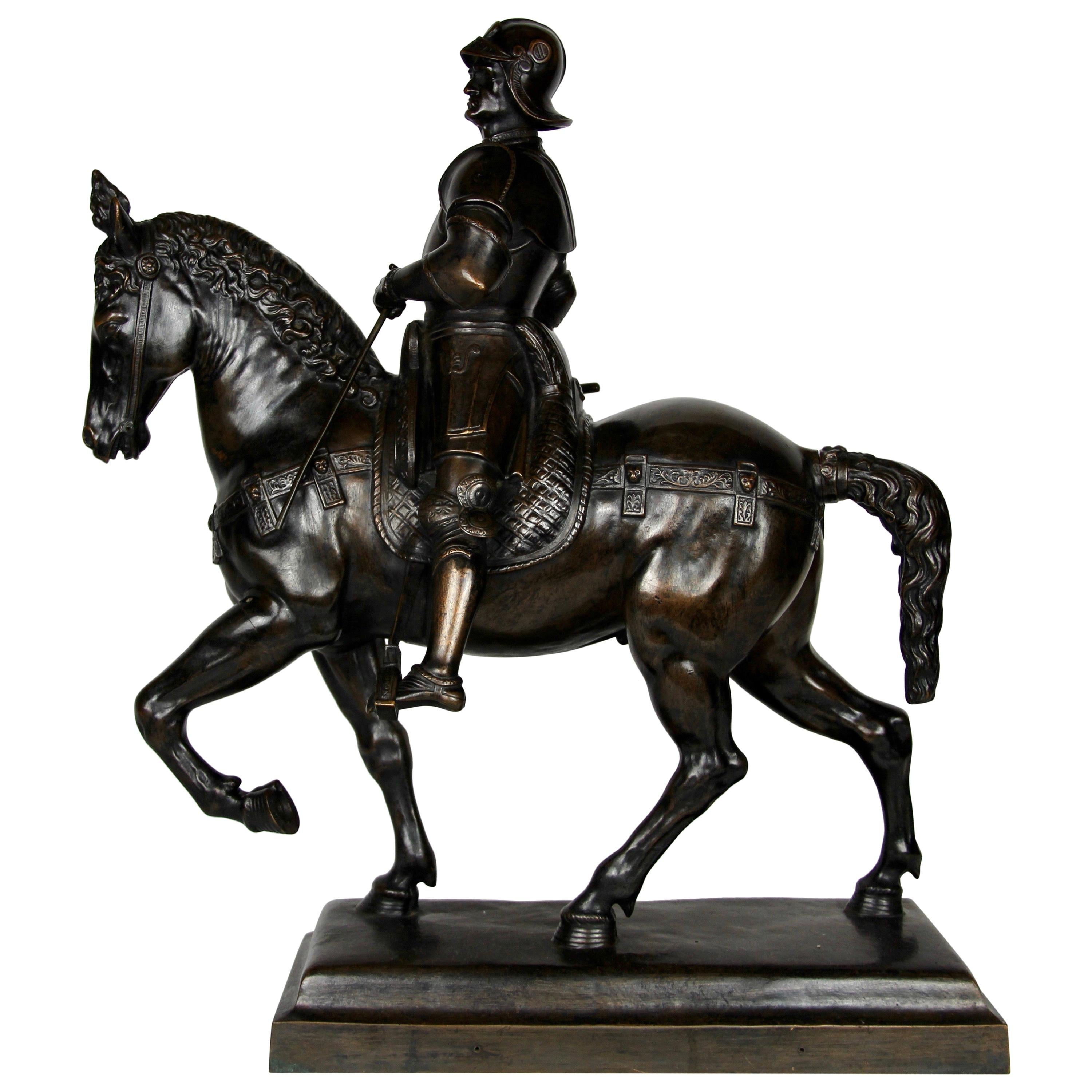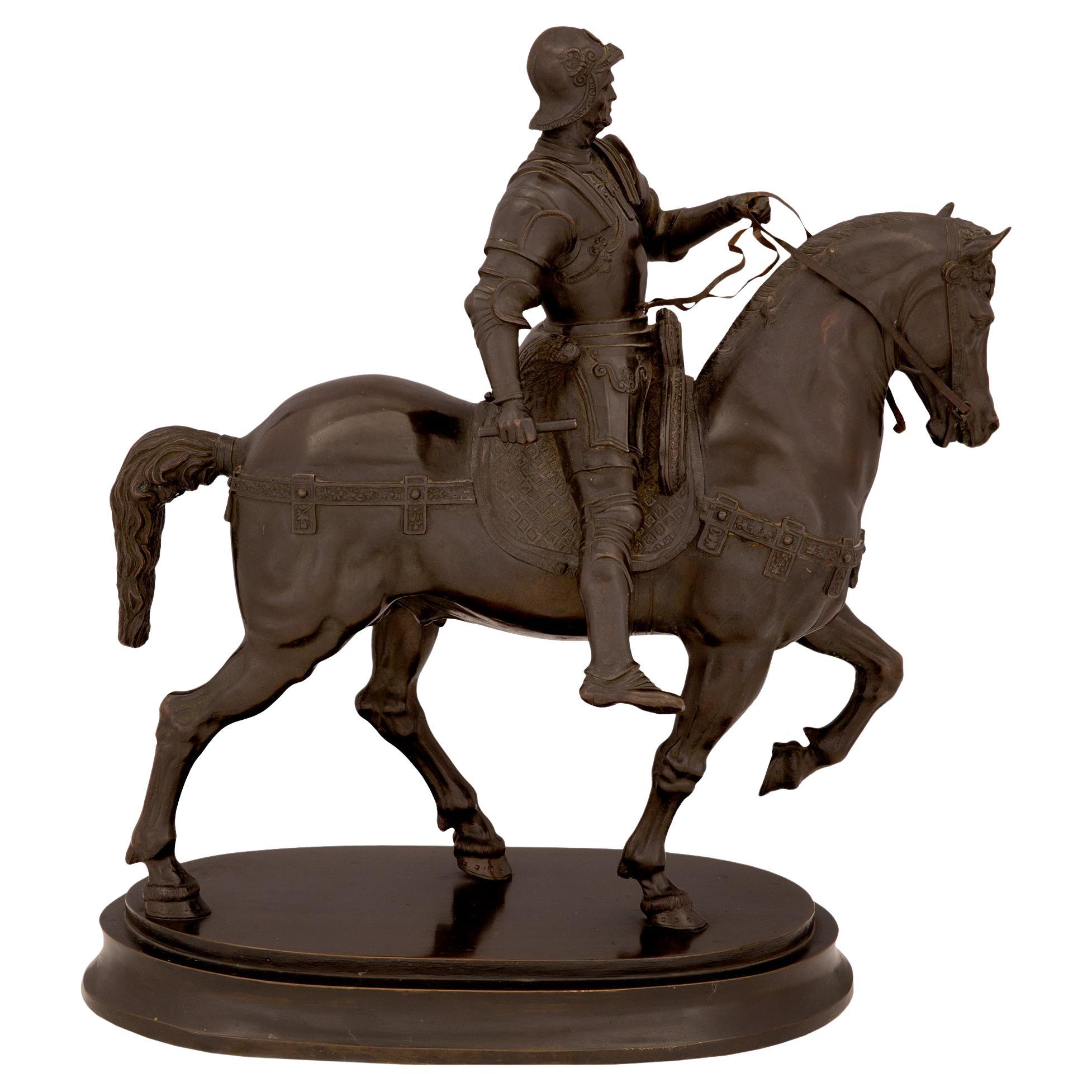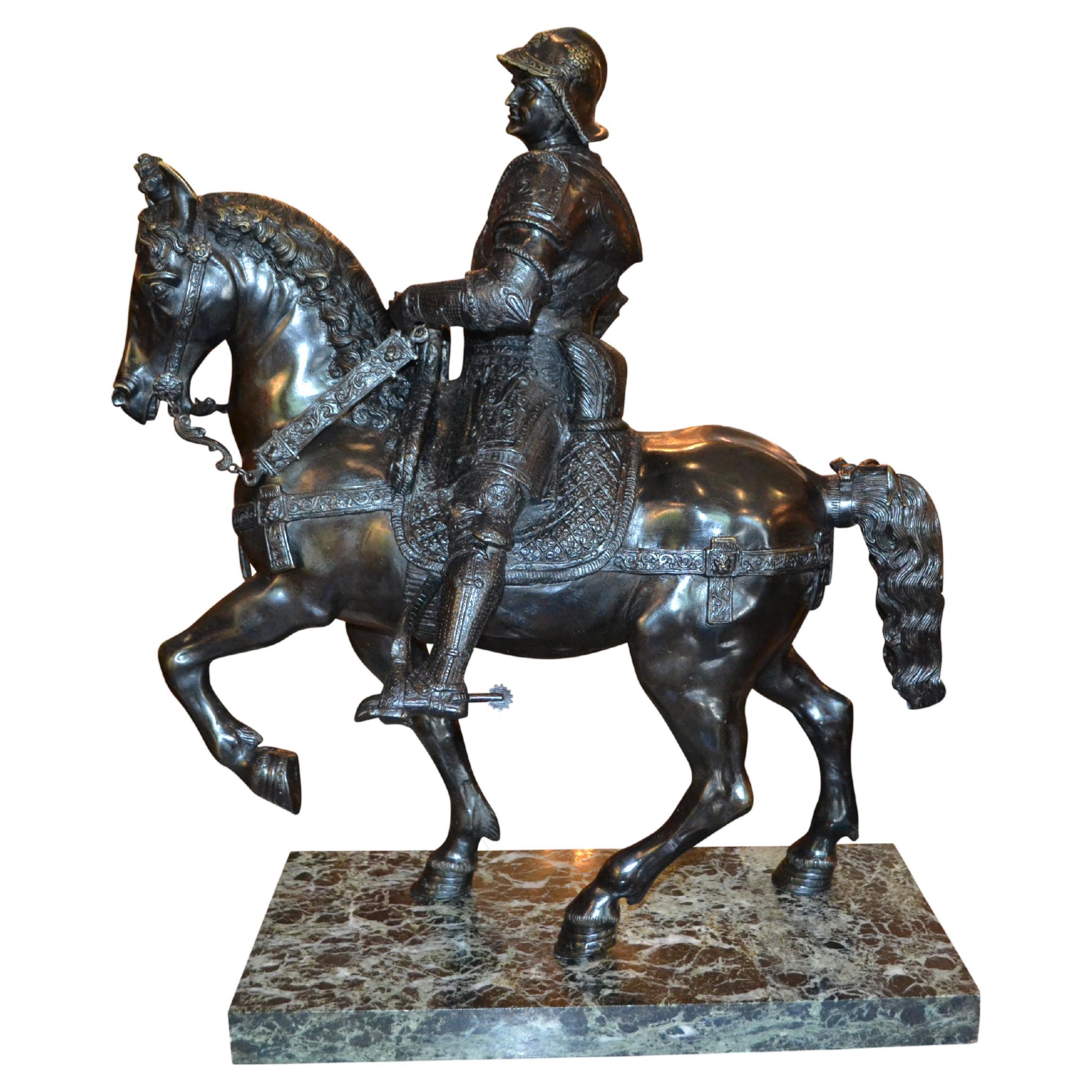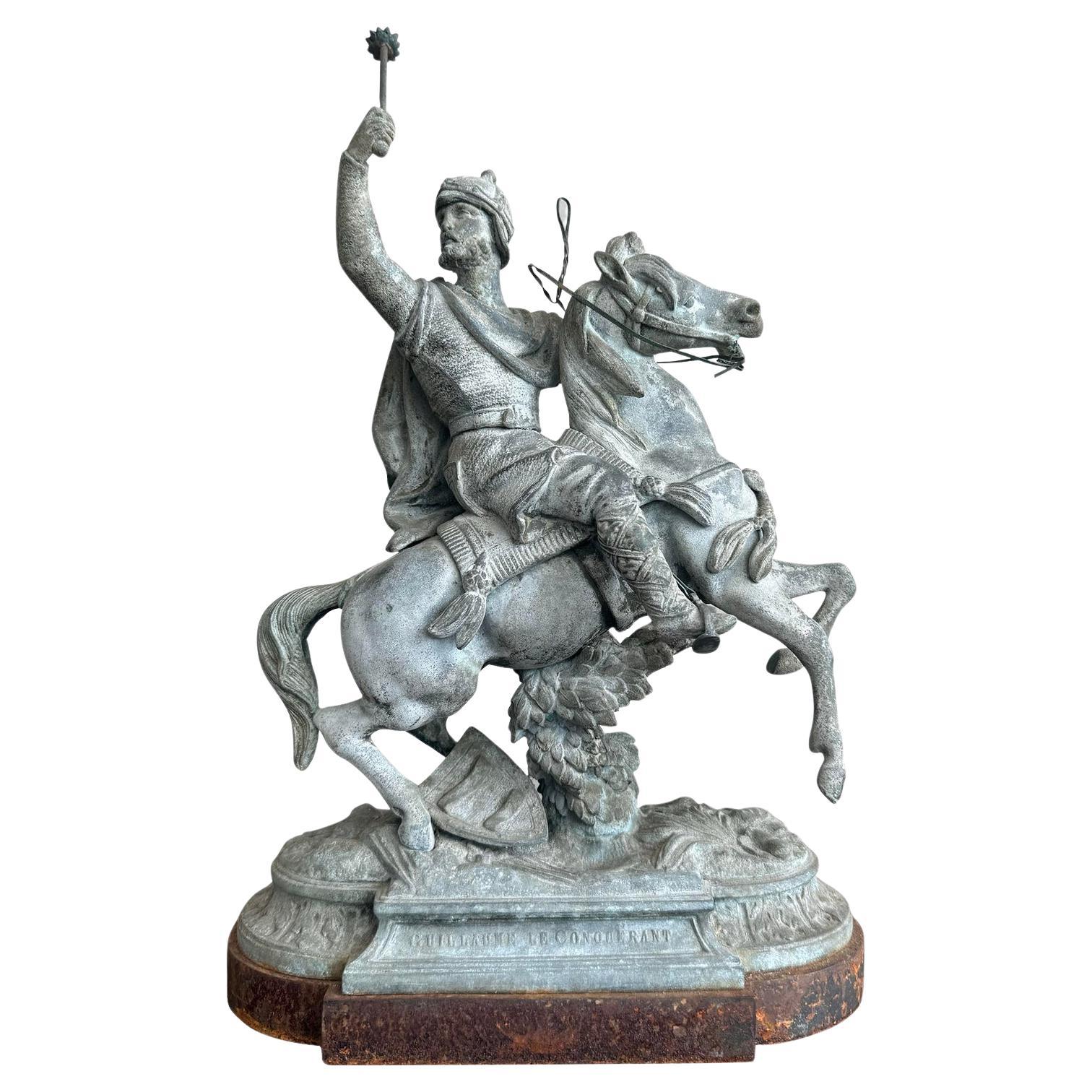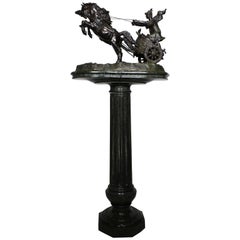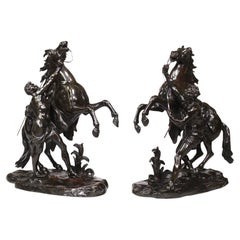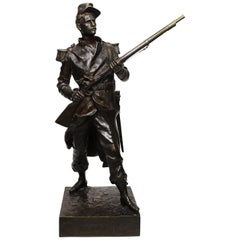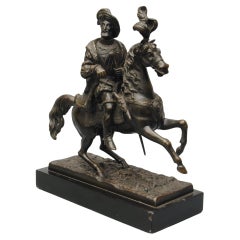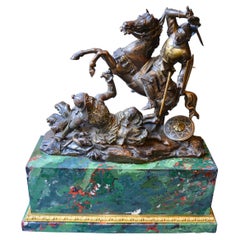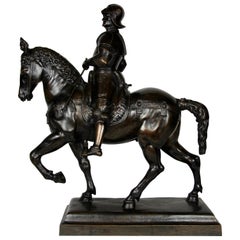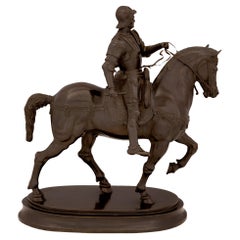Items Similar to A Monumental Bronze Sculpture of "Tartar Warrior Checking His Horse" after Barye
Video Loading
Want more images or videos?
Request additional images or videos from the seller
1 of 10
A Monumental Bronze Sculpture of "Tartar Warrior Checking His Horse" after Barye
$10,325
$14,75030% Off
£8,005.70
£11,436.7130% Off
€9,083.97
€12,977.0930% Off
CA$14,800.44
CA$21,143.4930% Off
A$16,093.37
A$22,990.5430% Off
CHF 8,479.64
CHF 12,113.7730% Off
MX$195,487.81
MX$279,268.3030% Off
NOK 106,606.16
NOK 152,294.5230% Off
SEK 99,934.67
SEK 142,763.8130% Off
DKK 68,167.24
DKK 97,381.7730% Off
About the Item
A Monumental Equestrian Patinated Bronze Group Sculpture of "Tartar Warrior Checking His Horse" after the original model by Antoine Louis Barye (French, 1795-1875). The large and heavy brown patinated sculpture depicting a male warrior in full armor riding his horse. The Tartars were fierce warriors. They were mounted archers who used speed, mobility and shock-power to overwhelm their enemies. Unsigned. Circa: Last quarter of 20th Century.
Antoine-Louis Barye’s masterful sculptures of animals—which included both miniatures and monumental pieces—earned him commissions from aristocrats and royals in France and made him a prominent member of Les Animaliers, a group of French artists who specialized in realistic renderings of animals. Barye’s depictions of animals, such as Tiger Surprising an Antelope (1857), illustrate the artist’s expert understanding of anatomy. This skill earned him the admiration of Auguste Rodin, who studied briefly with Barye at the Muséum d’Histoire Naturelle. After some initial metalwork training from his father, a goldsmith, Barye studied under master goldsmith Martin-Guillaume Biennais and sculptor François-Joseph Bosio before attending the École des Beaux-Arts. He first exhibited at the Salon in 1827, and he garnered attention and praise at his 1831 Salon showing for a sculpted scene of violent predators in the wilderness. Barye was commissioned to sculpt allegorical groups representing Strength, Order, Peace, and War for the façade of the Musée du Louvre as well as a series of decorative masks for the Pont Neuf, among other prominent public works.
Literature:
Jane Horswell, Bronze Sculpture of 'Les Animaliers', Reference and Price Guide, Suffolk, 1971, p. 45, illus. of another cast
Stuart Pivar, The Barye Bronzes, Woodbridge, 1974, illus. on the cover and p. 59, F9, another model shown with differing base
M. Poletti and A. Richarme, Barye. Catalogue raisonné des sculptures, Paris, 2000, pp. 76-77, no. F10, illus. of another cast
Height: 57 inches (144.8 cm)
Width: 57 inches (144.8 cm)
Depth: 24 1/2 inches (62.2 cm)
- Similar to:Antoine-Louis Barye (Sculptor)
- Dimensions:Height: 57 in (144.78 cm)Width: 57 in (144.78 cm)Depth: 24.5 in (62.23 cm)
- Style:Islamic (In the Style Of)
- Materials and Techniques:Bronze,Patinated
- Place of Origin:
- Period:
- Date of Manufacture:Circa: Last quarter of 20th Century
- Condition:Wear consistent with age and use. Minor fading. A truly beautiful and large sculpture, great for indoor or an outdoor fountain. Please view all images.
- Seller Location:Los Angeles, CA
- Reference Number:Seller: Ref.: A2705 - Lot 8346 1stDibs: LU1796234987382
About the Seller
5.0
Vetted Professional Seller
Every seller passes strict standards for authenticity and reliability
Established in 1982
1stDibs seller since 2016
136 sales on 1stDibs
Typical response time: 1 hour
- ShippingRetrieving quote...Shipping from: Los Angeles, CA
- Return Policy
Authenticity Guarantee
In the unlikely event there’s an issue with an item’s authenticity, contact us within 1 year for a full refund. DetailsMoney-Back Guarantee
If your item is not as described, is damaged in transit, or does not arrive, contact us within 7 days for a full refund. Details24-Hour Cancellation
You have a 24-hour grace period in which to reconsider your purchase, with no questions asked.Vetted Professional Sellers
Our world-class sellers must adhere to strict standards for service and quality, maintaining the integrity of our listings.Price-Match Guarantee
If you find that a seller listed the same item for a lower price elsewhere, we’ll match it.Trusted Global Delivery
Our best-in-class carrier network provides specialized shipping options worldwide, including custom delivery.More From This Seller
View AllItalian 19th Century Bronze Sculpture Group of a Two-Horse Roman Chariot & Rider
Located in Los Angeles, CA
A fine and large Italian 19th century Greco Roman style brown patinated bronze sculpture group of a two-horse Roman Chariot and rider in a dark patina, raised on a fitted Verde d'alp...
Category
Antique 19th Century Italian Greco Roman Figurative Sculptures
Materials
Marble, Bronze
$12,950 Sale Price
22% Off
Pair of French 19th/20th Century Patinated Bronze Sculptures "The Marly Horses"
By Guillaume Coustou
Located in Los Angeles, CA
A Fine Pair of French 19th/20th Century Patinated Bronze Sculptures of "The Marly Horses" After the original by Guillaume Coustou (French, 1677-1746). The large pair of equestrian br...
Category
Antique Early 1900s French Louis XV Figurative Sculptures
Materials
Bronze
French 19th Century Bronze Military Figure of "Blandan" after Jean Gautherin
By Jean Gautherin
Located in Los Angeles, CA
A very fine French 19th century patinated bronze figure of the French hero of the Algerian conquest, Jean-Pierre Hippolyte Blandan (1819-1842) after the French Sculptor Jean Gautheri...
Category
Antique 19th Century French Louis Philippe Figurative Sculptures
Materials
Bronze
$9,850 Sale Price
20% Off
French 19th Century Patinated Bronze Group "The Abduction of the Sabine Women"
By Pierre Loison 1
Located in Los Angeles, CA
A very fine and Monumental French 19th century patinated bronze group Titled "The Abduction of the Sabine Women" after a model by Pierre Loison (French, 1816-1886), depicting a young scantily maiden being carried away on the arms of a Roman soldier, raised on circular ebonized wood and brass revolving pedestal stand. Signed at the base: P. Loison, circa: Paris, 1870-1880.
Overall height (Sculpture and Pedestal): 91 inches (231.2 cm).
Sculpture height: 54 3/4 inches (139.1 cm).
Sculpture width: 24 inches (61 cm).
Pedestal height: 36 inches (91.5 cm).
Pedestal width (Widest): 25 1/2 inches (64.8 cm).
Pierre Loison was a French sculptor of the 19th century born in the seaside town of Loir-et-Cher on July 5, 1816 and died in Cannes on February 3, 1886. In 1841, he joined the Pierre-Jean David d'Angers workshop where he became one of his favorite pupils. A year later he attended the School of Fine Arts in Paris. He exhibited for the first time at the Salon des artistes Français where in 1845 he was awarded third-class medal. In 1853 he was awarded First Place medal and at the Universal Exhibition of 1955 he received an honorable mention and another medal award in 1859.
On 12 July 1859 and by decree, he was made "Chevalier de la Légion d’Honneur".
Pierre Loison is buried at The Montparnasse Cemetery in Paris.
Works by Pierre Loison
"Femme assise": Terre cuite (1843) au musée Gustave-Moreau à Paris
"Jeune fille portant un vase": Statue en marbre blanc, (h. 1,25 m) datée de 1857 et présentée au Salon de 1859 ; la statue fut d’abord placée au Palais-Royal (appartements du prince Napoléon) ; elle est actuellement au musée des Beaux-arts de Dole ; une réplique de taille réduite est au Musée des arts décoratifs de Paris.
"La Halle aux grains de Mer": Chaque façade de ce bâtiment, classé à l’inventaire supplémentaire des monuments historiques, comporte un fronton triangulaire et celui de la façade ouest représentant « L’Agriculture distribuant des couronnes aux enfants de Beauce et de Sologne » a été sculpté gracieusement par P. Loison, natif de la commune.
"La Justice assise": Allégorie de la Justice au fronton du Palais de justice de Blois (1847).
"Buste d’Achille Fould": Au musée du Château de Blois 8;
"Nausicaa": Statue en plâtre présentée au Salon de 1874, au musée des Beaux-arts de Vendôme.
"Statue de J-B. Pigalle sur la façade de l’hôtel de ville de Paris
"Sculptures extérieures du Palais du Louvre": Pierre Loison est l’auteur de neuf statues qui décorent les façades du Louvre "Figure" (1878) au deuxième étage du Pavillon Marsan10; "La Navigation" (1868) sur la balustrade du premier étage du Pavillon des États11; "Pandore" (1861) sur l’aile Est12; « Vénus » (1865) Aile Marsan13; "l’Histoire et la Vérité" (1857)14; "La Poésie et la Philosophie" (1857)15 deux oculi du Pavillon Mollien, coté cour Napoléon ; "Concordet" (1857) sur la balustarde du premier étage de la Rotonde de Beauvais, coté cour Napoléon.
"Statue de Sappho sur le rocher de Leucade : datée de 1859, (h. 1,85 m) sur la façade nord de la cour carrée du Palais du Louvre à Paris ; le modèle en plâtre, offert par Mme Loison, est au musée des Beaux-arts de Blois.
"Vierge à l’enfant": Statue en marbre en l’église Saint-Pierre de Dampierre-en-Yvelines.
"Jeune romain enlevant une Sabine": Groupe présenté au Salon de 1863 qui a été reproduit en bronze par la fonderie d’art Raingo frères.
"Sépulture de la famille Hautoy : Au cimetière du Père-Lachaise, deux bas-reliefs en marbre représentant l’un "La vie de Famille," l’autre 'Le chantier," datés de 1880.
"Demoiselle d’honneur de la Cour de François Ier": Statue en pierre exposée au Salon des artistes vivants en 1870 ; acquise par l’État à ce Salon, elle a été déposée en 1891, devant la mairie d’Aubin.
"La Paix distribuant des palmes aux génies des Beaux-arts": Fronton du Château de Compiègne (1866).
"Daphnis et Naïs": Groupe en marbre (1869) au musée de Picardie à Amiens.
"Jean-Baptiste Pigalle": Statue en pierre (1881) sur la façade principale, au rez-de-chaussée de l’Hôtel de ville de Paris.
"Gisant de Ferdinand-Philippe d'Orléans: dans la chapelle royale de Dreux en collaboration avec Ary Scheffer.
"La Grace": Statue en marbre (1875) dans le grand foyer de l’opéra Garnier.
The Abduction of the Sabine Women
The Abduction of the Sabine Women is an episode in the legendary history of Rome, traditionally dated to 750 BC, in which the first generation of Roman men acquired wives for themselves from the neighboring Sabine families. Recounted by Livy and Plutarch (Parallel Lives II, 15 and 19), it provided a subject for Renaissance and post-Renaissance works of art that combined a suitably inspiring example of the hardihood and courage of ancient Romans with the opportunity to depict multiple figures, including heroically semi-nude figures, in intensely passionate struggle. Comparable themes from Classical Antiquity are the Battle of the Lapiths and Centaurs and the theme of Amazonomachy, the battle of Theseus with the Amazons.
The Abduction is supposed to have occurred in the early history of Rome, shortly after its founding by Romulus and his mostly male followers. Seeking wives in order to found families, the Romans negotiated unsuccessfully with the Sabines, who populated the area. Fearing the emergence of a rival society, the Sabines refused to allow their women to marry the Romans. Consequently, the Romans planned to abduct Sabine women, during a festival of Neptune Equester and proclaimed the festival among Rome's neighbours. According to Livy, many people from Rome's neighbours including folk from the Caeninenses, Crustumini, and Antemnates, and many of the Sabines attended. At the festival Romulus gave a Signal, at which the Romans grabbed the Sabine women and fought off the Sabine men. The indignant abductees were soon implored by Romulus to accept Roman husbands.
Livy says Romulus offered them free choice and promised civic and property rights to women. According to Livy, Romulus spoke to them each in person, declaring "that what was done was owing to the pride of their fathers, who had refused to grant the privilege of marriage to their neighbours; but notwithstanding, they should be joined in lawful wedlock, participate in all their possessions and civil privileges, and, than which nothing can be dearer to the human heart, in their common children." Responsibility of the men for meeting the needs of the children thus conceived was not included.
War with the Sabines and other tribes
Outraged at the occurrence, the King of the Caeninenses entered upon Roman territory with his army. Romulus and the Romans met the Caeninenses in battle, killed their king, and routed their army. Romulus later attacked Caenina and took it upon the first assault. Returning to Rome, he dedicated a temple to Jupiter Feretrius (according to Livy, the first temple dedicated in Rome) and offered the spoils of the enemy king as spolia opima. According to the Fasti Triumphales, Romulus celebrated a triumph over the Caeninenses on 1 March 752 BC.
At the same time, the army of the Antemnates invaded Roman territory. The Romans retaliated, and the Antemnates were defeated in battle and their town captured. According to the Fasti Triumphales, Romulus celebrated a second triumph in 752 BC over the Antemnates.
The Crustumini also started a war, but they too were defeated and their town captured.
Roman colonists subsequently were sent to Antemnae and Crustumerium by Romulus, and many citizens of those towns also migrated to Rome (particularly the families of the captured women).
The Sabines themselves finally declared war, led into battle by their king, Titus Tatius. Tatius almost succeeded in capturing Rome, thanks to the treason of Tarpeia, daughter of Spurius Tarpeius, governor of the citadel on the Capitoline Hill. She opened the city gates for the Sabines in return for "what they bore on their arms", thinking she would receive their golden bracelets. Instead, the Sabines crushed her to death with their shields, and her body was thrown from a rock known ever since by her name, the Tarpeian Rock.
The Romans attacked the Sabines, who now held the citadel. The Roman advance was led by Hostus Hostilius, the Sabine defence by Mettus Curtius. Hostus fell in battle, and the Roman line gave way, They retreated to the gate of the Palatium. Romulus rallied his men by promising to build a temple to Jupiter Stator on the site. He then led them back into battle. Mettus Curtius was unhorsed and fled on foot, and the Romans appeared to be winning.
At this point, however, the Sabine women intervened:
[They], from the outrage on whom the war originated, with hair dishevelled and garments rent, the timidity of their sex being overcome by such dreadful scenes, had the courage to throw themselves amid the flying weapons, and making a rush across, to part the incensed armies, and assuage their fury; imploring their fathers on the one side, their husbands on the other, "that as fathers-in-law and sons-in-law they would not contaminate each other with impious blood, nor stain their offspring with parricide, the one their grandchildren, the other their children. If you are dissatisfied with the affinity between you, if with our marriages, turn your resentment against us; we are the cause of war, we of wounds and of bloodshed to our husbands and parents. It were better that we perish than live widowed or fatherless without one or other of you."
The battle came to an end, and the Sabines agreed to unite in one nation with the Romans. Titus Tatius jointly ruled with Romulus until Tatius's death five years later.
The new Sabine residents of Rome settled on the Capitoline Hill, which they had captured in the battle.
Artistic representations:
The Rape of the Sabine Women by Johann Heinrich Schönfeld
The subject was popular during the Renaissance as symbolising the importance of marriage for the continuity of families and cultures. It was also an example of a battle subject in which the artist could demonstrate his skill in depicting female as well as male figures in extreme poses, with the added advantage of a sexual theme. It was depicted regularly on 15th-century Italian cassoni and later in larger paintings. A comparable opportunity from the New Testament was afforded by the theme of the Massacre of the Innocents.
Giambologna
The sculpture by Giambologna (1579–1583) that was reinterpreted as expressing this theme depicts three figures (a man lifting a woman into the air while a second man crouches) and was carved from a single block of marble. This sculpture is considered Giambologna's masterpiece. Originally intended as nothing more than a demonstration of the artist's ability to create a complex sculptural group, its subject matter, the legendary rape of the Sabines, had to be invented after Francesco I de' Medici, Grand Duke of Tuscany, decreed that it be put on public display in the Loggia dei Lanzi in Piazza della Signoria, Florence. True to mannerist densely packed, intertwined figural compositions and ambitious overinclusive efforts, the statue renders a dynamic panoply of emotions, in poses that offer multiple viewpoints. When contrasted with the serene single-viewpoint pose of the nearby Michelangelo's David, finished nearly 80 years before, this statue is infused with the dynamics that lead towards Baroque, but the tight, uncomfortable, verticality— self-imposed by the author's virtuosic restriction to a composition that could be carved from a single block of marble— lacks the diagonal thrusts that Bernini would achieve forty years later with his Rape of Proserpina and Apollo and Daphne, both at the Galleria Borghese, Rome.
The proposed site for the sculpture, opposite Benvenuto Cellini's statue of Perseus, prompted suggestions that the group should illustrate a theme related to the former work, such as the rape of Andromeda by Phineus. The respective rapes of Proserpina and Helen were also mooted as possible themes. It was eventually decided that the sculpture was to be identified as one of the Sabine virgins.
The work is signed OPVS IOANNIS BOLONII FLANDRI MDLXXXII ("The work of Johannes of Boulogne of Flanders, 1582"). An early preparatory bronze featuring only two figures is in the Museo Nazionale di Capodimonte in Naples. Giambologna then revised the scheme, this time with a third figure, in two wax models now in the Victoria and Albert Museum, London. The artist's full-scale gesso for the finished sculpture, executed in 1582, is on display at the Accademia Gallery in Florence.
Bronze reductions of the sculpture, produced in Giambologna's own studio and imitated by others, were a staple of connoisseurs' collections into the 19th century.
Nicolas Poussin
Nicolas Poussin produced two major versions of this subject, which enabled him to display to the full his unsurpassed antiquarian knowledge, together with his mastery of complicated relations of figures in dramatic encounter. One, now at the Metropolitan Museum of Art, was executed in Rome, 1634–35. It depicts Romulus at the left giving the Signal for the abduction.
The second version, of 1636–37, now at the Louvre Museum, shows that, though some of the principal figures are similar, he had not exhausted the subject. The architectural setting is more developed.
Peter Paul Rubens
Peter Paul Rubens painted a version of the subject about 1635–40. It is at the National Gallery, London.
Jacques-Louis David
Jacques-Louis David painted the other end of the story, when the women intervene to reconcile the warring parties. The Sabine Women Enforcing Peace by Running Between the Combatants (also known as The Intervention of the Sabine Women ) was completed in 1799. It is in the Louvre Museum.
David had worked on it from 1796, when France was at war with other European nations after a period of civil conflict culminating in the Reign of Terror and the Thermidorian Reaction, during which David himself had been imprisoned as a supporter of Robespierre. After David’s estranged wife visited him in jail, he conceived the IDEA of telling the story, to honor his wife, with the theme being love prevailing over conflict. The painting was also seen as a plea for the people to reunite after the bloodshed of the revolution.
The painting depicts Romulus's wife Hersilia — the daughter of Titus Tatius, leader of the Sabines — rushing between her husband and her father and placing her babies between them. A vigorous Romulus prepares to strike a half-retreating Tatius with his spear, but hesitates. Other soldiers are already sheathing their swords.
The rocky outcrop in the background is the Tarpeian Rock.
John Leech
The English 19th century satirical painter John Leech included in his Comic History of Rome a depiction of the Rape of the Sabine Women, where the women are portrayed, with a deliberate anachronism, in Victorian costume...
Category
Antique 19th Century French Mannerist Figurative Sculptures
Materials
Bronze
$55,880 Sale Price / set
55% Off
Gaston Leroux Bronze Figure of Aida on a Sphinx, French, 19th Century
By Gaston Vuevenot Leroux
Located in Los Angeles, CA
Gaston Leroux (French, 1854-1942). A very fine French 19th century polychromed and patinated bronze sculpture of "Aida" resting on a sphinx, her legs crossed and holding a gilt-bronze tambourine, after the model by Gaston Veuvenot Leroux "Aida, A Femme Au Tambourin Assise Sur Une Tete De Sphinx". Signed: Gaston Leroux, Paris, circa 1890.
Measures: Height 29 inches (74 cm).
Width 15 inches (38.1 cm).
Depth 15 inches (38.1 cm).
The opulent and extensively detailed version of Aida was inspired by ethnographic findings of the mid-19th century in ancient Egypt as well as the influences of theatre and costume design. Travelers to the East had often recorded their journeys, either in writing or in pictures, but the movement of Egyptomania was wider-reaching than Egyptology. The immensely popular vogue of Egyptomania is without doubt due to the success of performing arts in recreating this era, in particular, Giuseppe Verdi's Aida. Both the Cairo and Paris premieres created sensations so large that they influenced generations of artists from Alexander Cabanel to Cecil de Mille. In Aida, the ruins of Egypt were brought back to life in full color and scale before the eyes of a generation that would make history as romantics, adventurers and explorers.
The Cairo premier of Aida was entirely conceived by one of the foremost Egyptologists of the day, Auguste Mariette, who was assigned to the project by Khedive Ismail Pasha...
Category
Antique Late 19th Century French Egyptian Revival Figurative Sculptures
Materials
Bronze
$26,950 Sale Price
23% Off
Over-Lifesize Patinated Bronze Greco Roman Standing Half-Figure of Andromeda
Located in Los Angeles, CA
A fine over-lifesize patinated bronze Greco roman revival style standing half-figure of Andromeda, probably French, probably late 19th century or early 20th century. The heavily fine...
Category
Antique Late 19th Century French Greco Roman Figurative Sculptures
Materials
Bronze
You May Also Like
Bronze Figure of Francois I on Horseback
Located in Lincolnshire, GB
A decorative French bronze figure of Francois 1st on his horse in full dress and the horse with a feather plume. Presented on a black marble base.
Category
Antique Mid-19th Century European Figurative Sculptures
Materials
Bronze
Bronze Statue of a Mounted Crusader in Combat with a Saracen After T. Gechter
By Jean-François Théodore Gechter
Located in Vancouver, British Columbia
A dramatic patinated bronze statue depicting a mounted crusader on his rearing horse ready to strike a mortal blow to a fallen Saracen lying beneath him on a rocky landscape. In a desperate attempt to defend himself the Saracen is shown thrusting his sword into the chest of the the crusader's horse. The bronze grouping is mounted on a green scagllola painted marble base with gilt bronze trim.
While the bronze is not signed it had to be cast after a hugely famous bronze very similar statue by Jean-François-Théodore Gechter (1795, Paris - 1844, Paris) titled "The Combat of Charles Martel...
Category
Antique Late 19th Century French Renaissance Figurative Sculptures
Materials
Marble, Bronze
Patinated Bronze Figure of a Soldier on a Horse with a Helmet
By Lauchhammer
Located in New York, NY
A Fabulous and Large Patinated Bronze Figure of a Soldier on a Horse. Beautifully cast and well patinated with a dark brown patina. The soldier is seen seated on a horse, beautifully...
Category
Vintage 1920s German Other Animal Sculptures
Materials
Bronze
Italian 19th Century Patinated Bronze Statue of a Nobleman on His Horse
Located in West Palm Beach, FL
An exceptional and high quality Italian 19th century patinated bronze statue of a nobleman 'Condottiero Bartolomeo Colleoni' on his horse. The statue is raised by an elegant oval bas...
Category
Antique 19th Century Italian Figurative Sculptures
Materials
Bronze
Grand Tour Bronze of the Equestrian Statue of Colleoni After Verrocchio
By Andrea del Verrocchio
Located in Vancouver, British Columbia
A very finely cast late 19 century Grand Tour bronze replica of the renowned statue of Bartolomeo Colleoni on horseback set on a verde antico marble base after the life sized bronze statue by the Renaissance sculptor Andrea Del Verrocchio...
Category
Antique Late 19th Century Italian Renaissance Animal Sculptures
Materials
Bronze
Vintage Statue With Warrior on Horseback
Located in West Palm Beach, FL
This dramatic sculpture depicts a triumphant mounted figure mid-charge, rendered in a weathered gray finish that echoes aged bronze. With one hand raised in victory and the other com...
Category
Mid-20th Century American Classical Roman Figurative Sculptures
Materials
Bronze
More Ways To Browse
Islam Gold
Warrior Horse
Horse Armor
Martin Guillaume Biennais
Barye Horse
Terracotta Relief
Victorian Porcelain Figurines
Vintage Furniture Kenya
Worker Bronze
19th Century Indian Bronze
Antique Hoe
Art Plinth
Balinese Antique Furniture
Battle Of Waterloo
Bronze Sculpture Ferdinand Barbedienne
Cold Painted Bronze By Franz Xaver Bergmann
Fig Leaf
Girl With Basket

